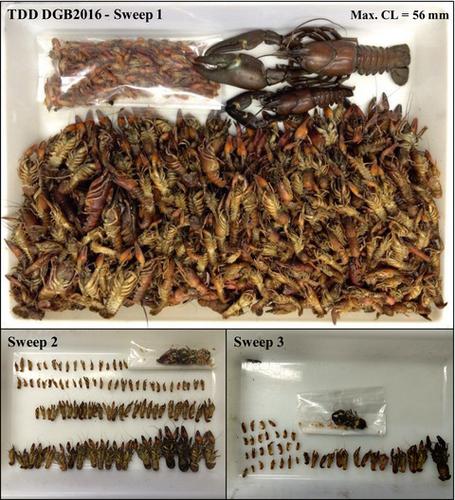当前位置:
X-MOL 学术
›
J. Appl. Ecol.
›
论文详情
Our official English website, www.x-mol.net, welcomes your feedback! (Note: you will need to create a separate account there.)
A novel ‘triple drawdown’ method highlights deficiencies in invasive alien crayfish survey and control techniques
Journal of Applied Ecology ( IF 5.7 ) Pub Date : 2020-10-12 , DOI: 10.1111/1365-2664.13758 Daniel D. A. Chadwick 1, 2 , Eleri G. Pritchard 1 , Paul Bradley 2 , Carl D. Sayer 1 , Michael A. Chadwick 3 , Lawrence J. B. Eagle 2 , Jan C. Axmacher 1, 4
中文翻译:

一种新颖的“三重缩水”方法突显了入侵小龙虾调查和控制技术的缺陷
更新日期:2020-10-12
Journal of Applied Ecology ( IF 5.7 ) Pub Date : 2020-10-12 , DOI: 10.1111/1365-2664.13758 Daniel D. A. Chadwick 1, 2 , Eleri G. Pritchard 1 , Paul Bradley 2 , Carl D. Sayer 1 , Michael A. Chadwick 3 , Lawrence J. B. Eagle 2 , Jan C. Axmacher 1, 4
Affiliation

|
- Freshwater crayfish can be successful invaders that threaten native biota and aquatic ecosystems in numerous countries worldwide. Nonetheless, the inability of conventional crayfish survey techniques like trapping and handsearching to yield quantitative population data has limited the understanding of crayfish invasion biology and associated ecological impacts.
- Here, we employed a novel ‘triple drawdown’ (TDD) method to sample invasive populations of signal crayfish Pacifastacus leniusculus in a headwater stream in Northern England. The method was compared with conventional techniques of trapping and handsearching.
- The TDD method proved to be an effective technique with high capture efficiency, reporting signal crayfish densities from 20.5 to 110.4 animals/m2 at our study sites. These numbers exceed any previous estimates for similar streams.
- The TDD showed the vast majority of individuals across all sites were juvenile or sub‐adult (<26 mm CL), with only 2.3% of the population large enough (≥35 mm CL) to be caught in standard traps.
- Synthesis and applications. The triple drawdown (TDD) method demonstrates strong inefficiencies and biases in conventional crayfish survey and management techniques. Trapping is not recommended for representative sampling or control of juvenile dominated populations. TDDs, which can be adapted and modified to operate in multiple habitat types and freshwater systems, generate robust quantitative data on invasive crayfish population demographics in situ. This can advance our understanding of the biology of an important invader of freshwater systems around the world. Obtaining this data prior and post‐intervention is fundamental to evaluate invasive crayfish management, and we recommend the TDD method to assess the effectiveness of future control measures.
中文翻译:

一种新颖的“三重缩水”方法突显了入侵小龙虾调查和控制技术的缺陷
- 淡水小龙虾可能是成功的入侵者,威胁着全球许多国家的原生生物群和水生生态系统。但是,传统的小龙虾调查技术(例如诱捕和手工搜索)无法获得定量种群数据,这限制了对小龙虾入侵生物学及其相关生态影响的理解。
- 在这里,我们采用了一种新颖的“三重下降”(TDD)方法来对英格兰北部上游水域中的信号小龙虾Pacifastacus leniusculus的入侵种群进行采样。该方法与传统的诱捕和手工搜索技术进行了比较。
- TDD方法被证明是一种有效的技术,具有很高的捕获效率,在我们的研究地点报告小龙虾的信号密度从20.5到110.4动物/ m 2。这些数字超出了以前对类似流的估计。
- TDD显示,所有地点的绝大多数个人是未成年或亚成年(CL <26 mm),只有2.3%的人口足够大(≥35 mm CL)被标准诱捕器捕获。
- 综合与应用。三重缩水(TDD)方法显示出传统小龙虾调查和管理技术中的低效率和偏见。不建议使用诱捕方法进行代表性抽样或控制以青少年为主的种群。TDDs可以进行修改和修改以在多种栖息地类型和淡水系统中运行,可就入侵小龙虾种群人口统计数据生成可靠的定量数据。这可以增进我们对全球重要的淡水系统入侵者的生物学的了解。干预前后,获取这些数据是评估侵入性小龙虾管理的基础,我们建议采用TDD方法评估未来控制措施的有效性。


























 京公网安备 11010802027423号
京公网安备 11010802027423号